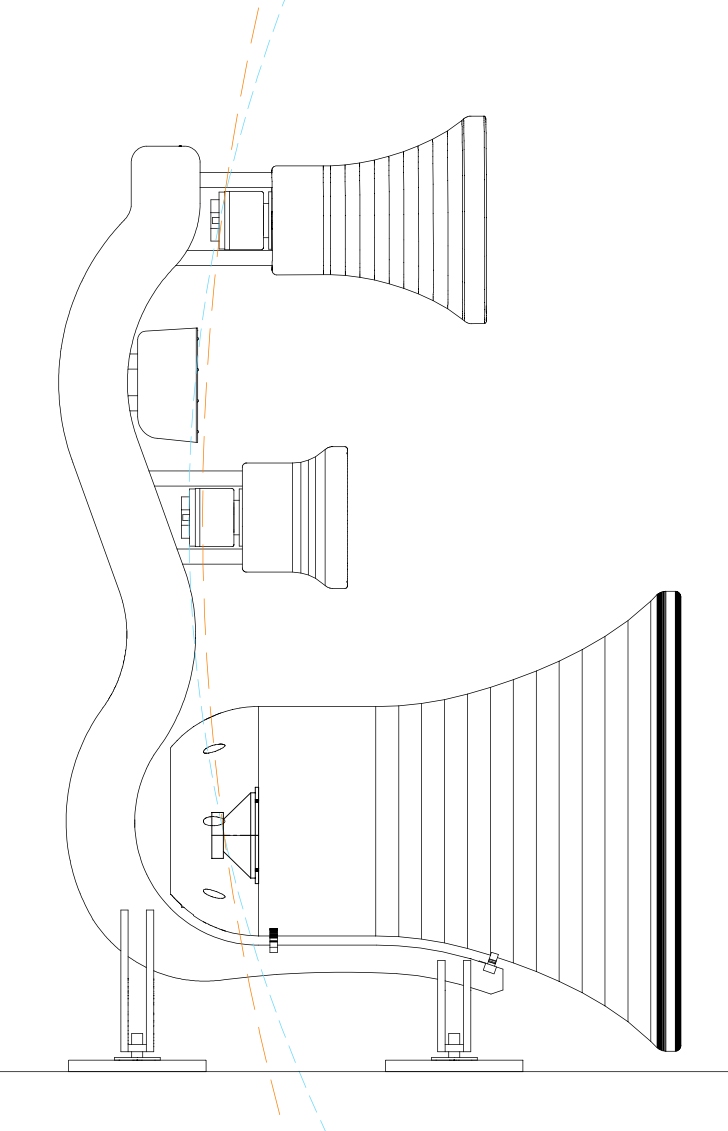|
fiogf49gjkf0d  Romy the Cat wrote: Romy the Cat wrote: |
Well, acg, I am not wild about your idea of the curved frame,
primary on the reason of esthetics but it is your speaker not mine and you
shall do whatever pleases you. A few mandatory things that I would like to
mention and I think you need to factor it into your design.
1) The Macondo channels shall form a curve or
parabola with your listening position being in center of a curve. I have illustrated
it years back at the following image: http://www.goodsoundclub.com/Site_Images/MacondoFrame31.jpg
I would very much discourage you to angle the horns and many foolish people do,
juts align the channels. To do so you would need to have a provision to move
the channels closer and further. Your current design does not allow you to do it.
You might avoid to move the channels closer and further if you calculate and
factor in the curvature and listening distance into the initials destine of the
channel arms.
|
|
Romy, here is a side elevation of sorts of the curved frame. In orange is the equal distance curve for a 3m listening distance measured from the upperbass driver as shown) with ears at the same level as the centre of the midrange horn (1.2m - about 4ft). The blue curve is for a 5m listening distance with the ears set at the same level as the centre of the midrange horn. The seating height is about right, it may end up a touch lower but I would be very surprised if is ends up any higher. The effect of a higher listening position is to push back all the higher channels above the upperbass, which this frame will not accommodate. The effect of a lower listening position is to draw forward all those channels, which this frame will accommodate.

Each of those three upper channels does have the ability to be moved forwards and backwards by adjusting two screws (one for each connecting 'rod' of each channel) and they have about 80mm-100mm (3" - 4") of horizontal movement available. Each turn of the screws will move the channel by 1.5mm which should be accurate enough. If I run out of adjustment I can do one of two things: add longer rods to that channel; move the upperbass horn forwards.
 Romy the Cat wrote: Romy the Cat wrote: |
2) During the alignment of the channels you do not need to drop a plumb bob from the horn throat or the driver exit but from the location of the driver diaphragm. The S2 have diaphragm on the back, so you overshooting in your design good 5-6 inches
|
|
Sorry Romy, but that image was just a demonstration of one way for you to measure the offset, and so long as you were able to identify where you measured from and to then I would be able to replicate it here and get the right result. I did not mean it as a literal "measure from here to here".
 Romy the Cat wrote: Romy the Cat wrote: |
3) The time integration of MF and Upperbass is tricky. You can calculate where the Fane diaphragm is, where the S2 diaphragm is and they pretty much not on a curve but on direct vertical line. The precession of that calculation is kind of not important as Fane is not flat and has dome depth of the diaphragm. So, doing subjective assessments of the integration benefits I realized that all that you need to do between those channels is putting the MF atop of the point of max amplitude of upperbass. 500Hz has a wavelength of around 2.2 feet, 1000Hz is around 1.1feet. With such a long wave you will have a very high precision alignment if you align them approximately by geometry and then lock acoustically by summation of amplitude measurement. I did exactly this and then, after I knew the final position of my MF driver I order a fixed, well calculated arm for my tweeter. In my case I make my MF drive to position atop of positioning table with .01mm accuracy. I personally do not feel it is the best idea and I would rather advise to make HF being able to be .01mm positioned by MF would be fine with 1-2mm. You would not need a machinist position table for it and some kind of general slider would be fine.
|
|
Thanks for this information Romy. Are you able to tell me the horizontal and vertical separation that you are using between the ubberbass and midrange channels? I would still like to be a little more sure before I get steel cut for the frames. I have the midrange horns built but the upperbass horns will not be ready for a while so I cannot measure it myself at this stage, and I would like to have the frames built, painted and ready to accept the upperbass horns as soon as I finish turning them.
 Romy the Cat wrote: Romy the Cat wrote: |
4) You do want to lock the location of the Midbass horn with the frame and it will be moving side to side. A horn that angles breaks time alignment.
|
|
Do you mean locking the upperbass horn to the frame? If so , then yes, that is my plan, mainly because it is so heavy and I would not look forward to moving it.
 Romy the Cat wrote: Romy the Cat wrote: |
PS: I won’t be reading too much at the Australian site not to mention that I can’t see the pictures. So, if you need anything then ask here. |
|
Will do, thankyou.
|